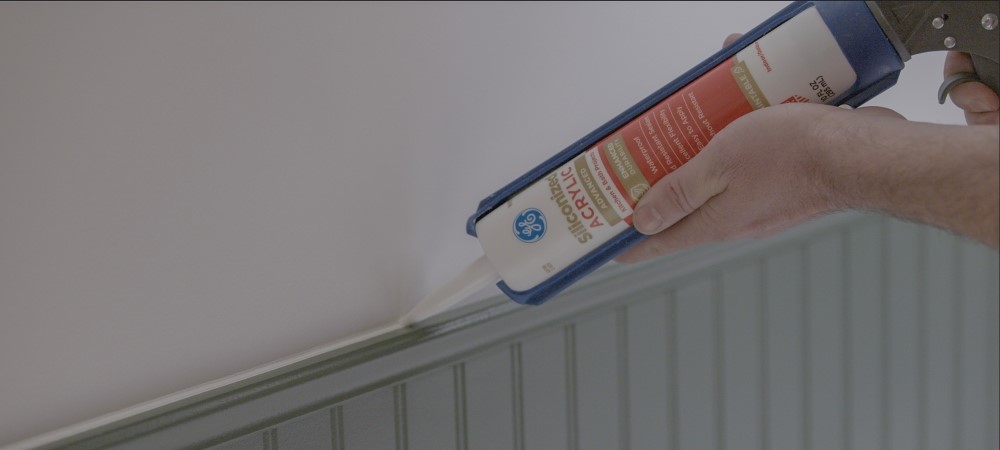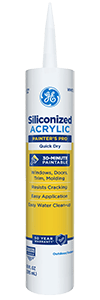Learning how to caulk baseboards the right way can make all the difference in the finished look of your room. Our step-by-step guide to caulking baseboards will help you achieve the seamless, professional look you want.
A step-by-step guide on how to caulk baseboards
Follow these steps for a high-quality finish that looks great and lasts a long time.
-
Gather Your Supplies
Before you begin, gather all the supplies. You’ll need:
- Caulk gun
- Painter’s tape
- Paintable, flexible acrylic latex caulk
- Utility knife or caulk removal tool
- Rags or paper towels
- Rubbing alcohol
- Gloves (optional)
-
Prepare the Surface
Thoroughly clean the area around the baseboards. Use a damp cloth or vacuum cleaner to remove any dust, dirt, or debris. For best results, cleanse the surface with rubbing alcohol to ensure it’s free of any grease or residue, which could interfere with adhesion.
-
Apply Painter’s Tape
To protect the surrounding surfaces from excess caulk and ensure clean lines, apply painter’s tape along the edges of the baseboards and adjacent walls. Press the tape firmly to prevent caulk from seeping underneath.
-
Load the Caulk Gun
Place the caulk or sealant tube in the caulk gun. Cut the nozzle tip at a 45-degree angle using a utility knife and pierce the seal. The size of the opening will determine the thickness of the caulk bead. Start with a smaller cut, adjusting as needed.
-
Apply the Caulk
Hold the caulk gun at a 45-degree angle. Squeeze the trigger slowly to dispense a continuous bead of caulk along the gap between the baseboard and the wall. Use steady pressure and keep the caulk gun moving smoothly to ensure even coverage. Avoid applying too much caulk to prevent a messy finish.
-
Smooth the Caulk
Once you’ve applied the caulk, smooth the bead with a caulk smoothing tool or a damp finger. Work quickly but carefully to achieve a neat, uniform finish. Remove any excess caulk before it dries to avoid bumps or ridges.
-
Remove Painter’s Tape
While the caulk is still wet, pull off the painter’s tape at a 45-degree angle to reveal clean, crisp edges. Be careful not to smear or smudge the freshly applied caulk.
-
Clean Up
Dispose of used caulk tubes and wipe down your tools with a damp cloth or paper towel to remove any residual caulk. If you accidentally get caulk on your skin or clothing, use soap and water to clean it off before it dries.
-
Allow to Dry
Let the caulk dry following the manufacturer’s instructions before painting or exposing it to moisture. This typically takes anywhere from 24 to 48 hours, depending on the type of caulk and environmental conditions.
-
Paint (Optional)
If desired, paint the caulk after it cures to match the color of your baseboards and achieve a seamless finish. Use quality paint and apply evenly for the best look.
Repeat these steps to caulk the bottom of the baseboards to the floor.
Preparation is key! An improperly prepared surface will hinder the long-term adhesion of your caulk.
How to extend the lifespan of caulk on baseboards
Over time, the caulk along your baseboards may start peeling off or become discolored. To prevent this, follow these steps to extend the life of the caulk on your baseboards.
-
Choose the Right Caulk
Choosing a high-quality, paintable caulk specifically for indoor use is crucial for its longevity.
Acrylic latex and acrylic hybrid caulks are excellent choices for their durability and ease of application. Before purchasing, read the label to ensure the caulk is suitable for baseboards and the surrounding materials.
-
Prepare the Surface Properly
Good adhesion and caulk longevity start with proper surface preparation. As mentioned earlier, thoroughly clean the surface to remove any dirt, dust, grease, or old caulk residue. A mild detergent or rubbing alcohol works well. Allow the surface to dry completely before caulking.
-
Apply Caulk Correctly
Improper application can have a significant impact on caulk’s longevity. Avoid gaps, bubbles, or imperfections, as these can collect dust and weaken adhesion. Once applied, smooth it out carefully with your finger or a caulking tool.
-
Seal Joints and Gaps
In addition to caulking the gap between the baseboard and the wall, seal any other joints or large gaps in the baseboard itself. Inspect the baseboards for cracks, splits, or gaps and fill them with caulk.
Pay special attention to corners and where baseboards meet other trim pieces. This step helps prevent air leaks and moisture intrusion, which can weaken the caulk over time.
-
Monitor and Maintain
Regularly check the caulk for signs of wear, damage, or deterioration, such as cracks, shrinkage, or discoloration. If you detect any issues, promptly re-caulk or touch up the affected areas to prevent further damage.
Keeping the surrounding area clean and free of debris also helps maintain the caulk’s appearance and performance.
-
Consider Environmental Factors
Environmental factors such as temperature fluctuations, humidity levels, and exposure to sunlight can affect the durability of caulk. Choose a caulk suitable for your area’s environmental conditions.
For example, if you live in a region with extreme temperature variations, opt for a caulk that is formulated for both indoor and outdoor use and can withstand temperature extremes without cracking or shrinking.
Signs it’s time to re-caulk
Your baseboards will eventually need re-caulking. Look for these signs:
- Visible gaps
- Cracked or peeling caulk
- Discoloration
- Water damage
- Drafts or air leaks
If you notice these signs, remove the old caulk with a caulk removal tool or utility knife, taking care not to damage the surfaces. Once the old caulk has been removed, thoroughly clean the surface to remove any dirt and dust. Then, follow the step-by-step instructions on how to apply caulk.
While baseboards are easily overlooked, they give your home a clean, polished look. Choosing the right sealant for your baseboards will help them last longer and look better.
Looking to apply new caulk or sealant to your baseboards? Choose a GE Sealant product for reliable results.


